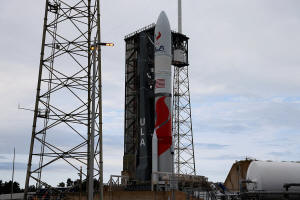New Vulcan rocket sends privately-built Moon lander to space
 Send a link to a friend
Send a link to a friend
 [January 08, 2024]
By Joey Roulette [January 08, 2024]
By Joey Roulette
WASHINGTON (Reuters) -A robotic lander built by a private company was
bound for the moon on Monday in an attempt to make the first U.S. lunar
soft landing in more than half a century, after launching into space
aboard a new Vulcan rocket debuted by a joint venture of Boeing and
Lockheed Martin.
Space robotics firm Astrobotic's Peregrine lunar lander launched at 2:18
a.m. EST from Cape Canaveral, Florida on the first flight of Vulcan, a
powerful rocket that had been under development for a decade by the
Boeing-Lockheed venture United Launch Alliance (ULA).
"Yee haw, I am so thrilled," ULA CEO Tory Bruno said in the company's
launch control room. "This has been years of hard work. So far this has
been an absolutely beautiful mission."
If all goes well, Peregrine would mark the first U.S. soft landing on
the moon since the final Apollo landing in 1972, and the first-ever
lunar landing by a private company - a feat that has proved elusive in
recent years.
"This is the moment we've been waiting for for 16 years," Astrobotic CEO
John Thornton said. Applause roared in the launch control room when
Peregrine was released from its booster stage, setting the golf
cart-sized craft on its 46-day journey to the moon.

The mission is the latest in recent years among countries and private
companies sprinting to the moon, a reemergent stage of international
competition where scientists hope its water-bearing minerals can be
exploited to sustain long-term astronaut missions.
The launch of Vulcan, a 200-foot (60-m) tall rocket with engines made by
Jeff Bezos' Blue Origin, was a crucial first for ULA, which developed
the rocket to replace its workhorse Atlas V rocket and rival the
reusable Falcon 9 from Elon Musk's SpaceX in the satellite launch
market.
The stakes were high for Vulcan. Boeing and Lockheed, which own ULA in a
50-50 split, have been seeking a sale of the business for roughly a
year. And the launch was the first of two certification flights required
by the U.S. Space Force before Vulcan can fly lucrative missions for the
Pentagon, a key customer.
[to top of second column]
|

Boeing-Lockheed joint venture United Launch Alliance’s
next-generation Vulcan rocket stands ready for launch on its debut
flight from Cape Canaveral, Florida, U.S. January 7, 2024.
REUTERS/Joe Skipper/ File photo

Peregrine is set to land on the moon on Feb. 23 with 20 payloads
aboard, most of which will seek to gather data about the lunar
surface ahead of planned future human missions. It marks the first
trek to the moon's surface as part of NASA's Artemis moon program.
That multibillion dollar program, involving various countries and
relying heavily on private companies such as SpaceX, envisions
astronaut missions to the moon later this decade. Small landers such
as Peregrine will get there first.
A second private U.S. company under the same NASA program expects to
launch a lander of its own in February. Carrying similar NASA
payloads and launching to space aboard a SpaceX Falcon 9 rocket,
Houston-based Intuitive Machines' said its spacecraft could make a
moon landing on Feb. 22, a day before Peregrine.
India last year became the fourth country to achieve a soft lunar
landing after Russia failed in an attempt the same month. The U.S.,
China and the former Soviet Union are the only other countries that
have carried out successful soft lunar landings.
Private companies with hopes of spurring a lunar marketplace have
had harder times, with Japan's ispace and an Israeli company
crash-landing on their first attempts.
(Reporting by Joey Roulette; Editing by Rosalba O'Brien, Jacqueline
Wong, William Maclean)
[© 2023 Thomson Reuters. All rights
reserved.]This material
may not be published, broadcast, rewritten or redistributed.
Thompson Reuters is solely responsible for this content.
 |